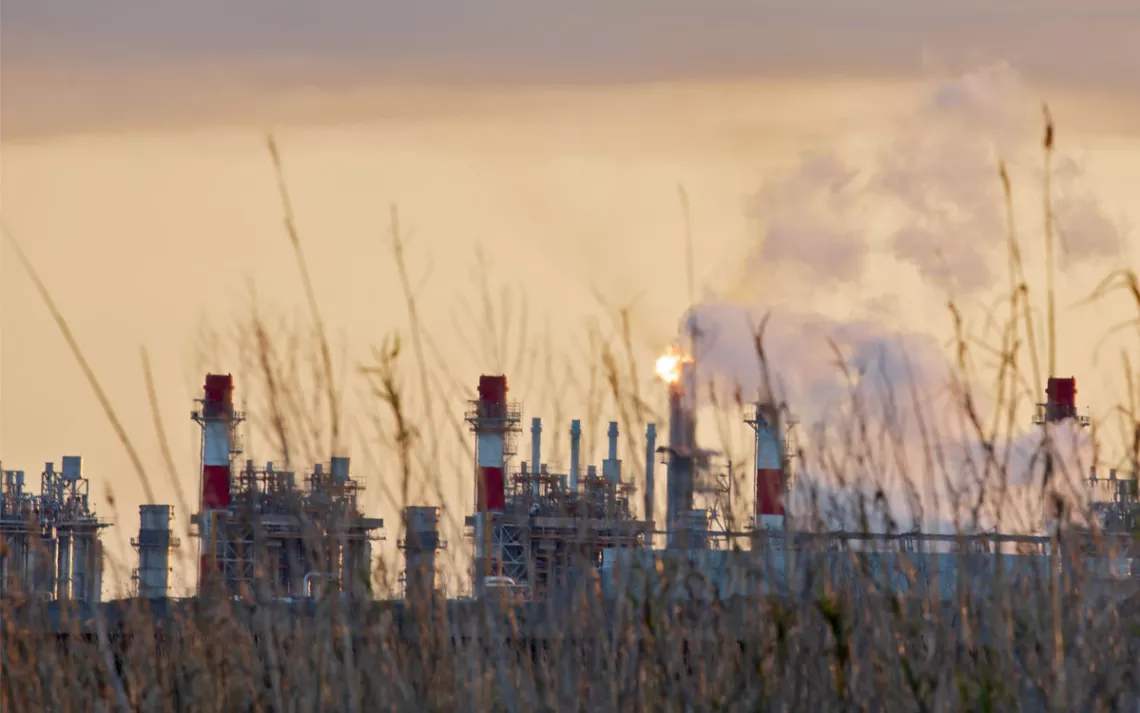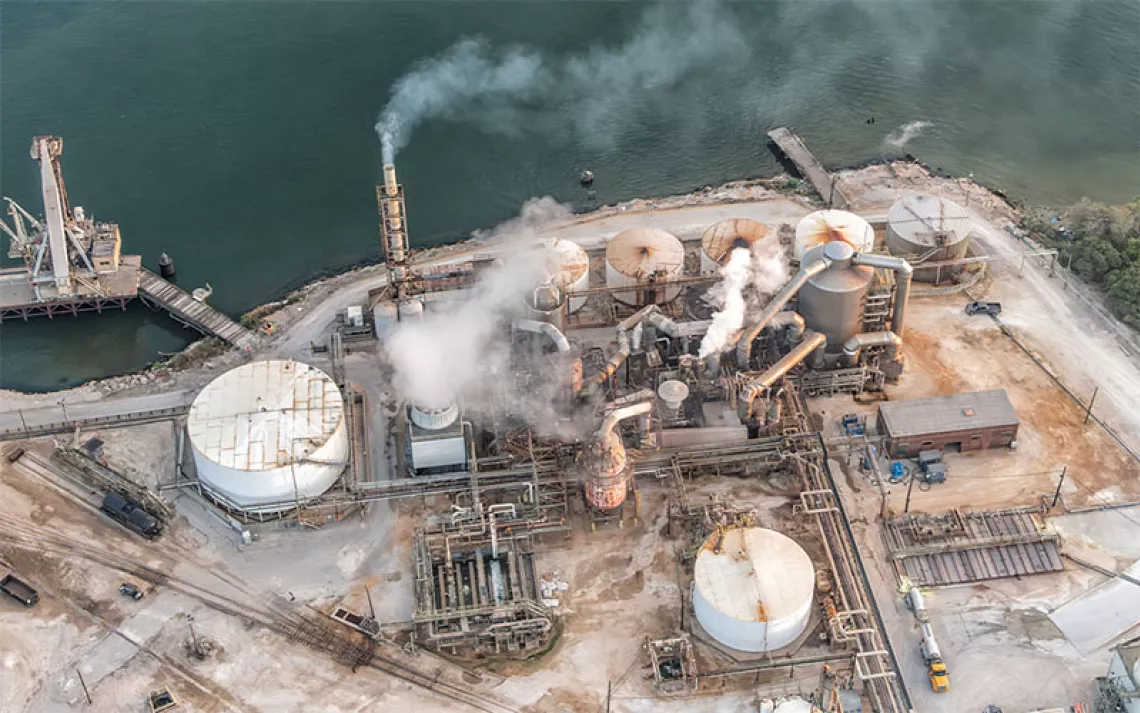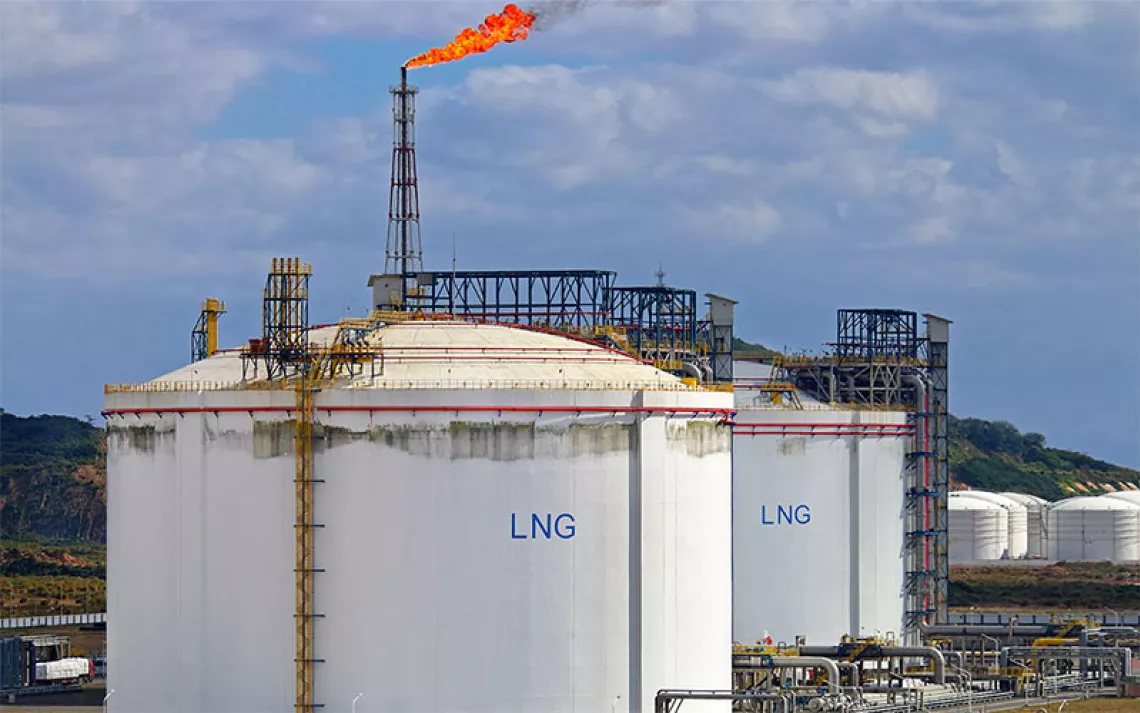Celebrating the End of the LNG Boom, Louisiana style
BBQ oysters and beer to wash away the carbon bomb on the Gulf Coast

The Calcasieu Pass LNG terminal, one of several in Cameron Parish, Louisiana. | Photo by Julie Dermansky
John Allaire was having a good day.
“Show ’em your redfish!” he hollered over his shoulder at his friend Matt. Matt hoisted a fish the size of a small toddler out of a white bucket, beaming. “And these are just the small ones.”
Allaire, warm and easygoing, sporting a short gray beard and a camo jacket, is a retired environmental engineer who once worked in the oil and gas industry. On this winter day in Cameron, Louisiana, he and Matt had spent all morning fishing and duck hunting. Now they were reaping the rewards. Allaire had fired up the gas grill next to his camper and was already busy making his specialty, jalapeño poppers—peppers grown in his garden stuffed with shrimp he caught himself. “We live off the land down here,” Allaire said coyly, cracking a Busch beer.
The friends got to work. Allaire gripped a massive oyster in a blue dishrag. “This is my technique,” he explained cheerfully, balancing the oyster on edge. “Find the eye.” With one hand, he worked the shucking knife into the hinge. Then he picked up an old hammer and enthusiastically whacked the butt of the shucking knife until the oyster popped open. His dog Chula watched, rapt. Allaire handed the empty half to her, and she trotted off happily with the shell in her mouth, curling up in the grass near where Matt cleaned the redfish, “like a pro,” Allaire noted.
“I found a pearl the other day,” Allaire announced, as he moved on to the next oyster. “About a quarter inch long. I kept it.” Whack. “There’s a beautiful oyster, right there.” He showed it off, smiling. Two more coolers packed with oysters waited at his feet. Allaire used to harvest oysters along the Calcasieu Ship Channel. But ever since Commonwealth LNG started leasing that land for its future liquefied natural gas (LNG) terminal, no one is allowed out there anymore. So Allaire had to buy these ones from a local fisher.
Much of the land surrounding the camper is charred black from a wildfire, making it appear that Allaire has conjured abundance out of nothing. His camp, neatly kept and set on a concrete slab under a pitched roof, lies on a spit of coastal wetland by the bank of the channel in Louisiana’s southwest corner. Out back is a greenhouse he built himself from hurricane debris. His south lawn dissolves into brackish marsh, busy with ducks and ibis and roseate spoonbills, and just beyond that lies the Gulf of Mexico.
Allaire’s property also sits at the heart of one of the largest fossil fuel buildouts in history: the rapid expansion of LNG exports.
Across the channel, clearly visible from Allaire’s camp, towers Venture Global’s Calcasieu Pass terminal. The complex, spanning 1,000 acres, has already racked up thousands of permit violations, though it began producing LNG only two years ago and is not yet officially operating. That has not stopped the terminal from near constant gas-flaring, which Allaire has documented with a camera fastened to one of his carport beams.
Next to Calcasieu Pass, Venture Global is planning a second, larger terminal, CP2, which would be the largest in the United States. Meanwhile, Commonwealth is building its terminal atop Allaire’s old oyster harvesting grounds. Elsewhere in Cameron Parish, there’s Cheniere Energy’s Sabine Pass project in Johnson Bayou, Cameron LNG in Hackberry, and five other plants announced but not yet under construction. Since 2016, when the export of liquefied gas was first allowed, exports have skyrocketed, even as they have driven up the cost of energy at home. The United States is now the world’s leading LNG exporter, and most of it comes from right here in Cameron Parish.
Allaire grew up near Buffalo, New York, but came to the Gulf when he was 17. Back then, over 200 fishing boats docked in Cameron. Otters and dolphins played in the channel, and in the summer, tourists flopped onto nearby Holly Beach, just around the bend.
Tourists don’t come around much anymore. Since 2005, the community has been battered by a succession of powerful hurricanes fueled by the Gulf’s warming waters. Cameron, once home to over 2,000 people, has only a few hundred residents left, and only a handful of fishing boats. Powerful wakes created by the massive LNG tankers have eroded the fragile banks of the channel. It used to be significantly narrower; now it laps yards from the edge of a coastal road, and trees and telephone poles tip toward the water.
As the oysters slowly broiled, Allaire walked down to the marsh’s edge. “I’ve seen 2,200 ducks on this pond at one time,” he recalled. “It’s just a really poor year because of the fires and the drought we’ve had this year.” Just a couple months earlier, the wildfires, which plagued this region’s hottest summer ever, had raged right up to his residence. Fires are not a typical threat in southern Louisiana, but now blackened marsh grass reached almost to his feet. “We were here with the firefighters, or it would’ve burnt right up,” he said. A metal sink and a burned engine block stood out in the cinders. Lucky for all concerned, the fires never reached the LNG terminals.
Dinner was ready. Allaire plated up the food as he and Matt talked about Hurricane Ida and ducks and good hunting dogs. Over the Gulf’s bounty, sunset turned to dusk turned to night. Any stars, however, were drowned out by the lights of the LNG terminal blazing all night long.
“That other one,” he said, referring to the coming Commonwealth terminal, “is gonna be about 750 feet from my property line.” Then he caught himself. “The proposed one,” he clarified. “We’re gonna get it stopped.”
Turns out Allaire was right. Six weeks after his cookout, the White House announced a pause on all new LNG export terminals, including CP2, until the Department of Energy can assess their climate implications.
 The Magazine of The Sierra Club
The Magazine of The Sierra Club



